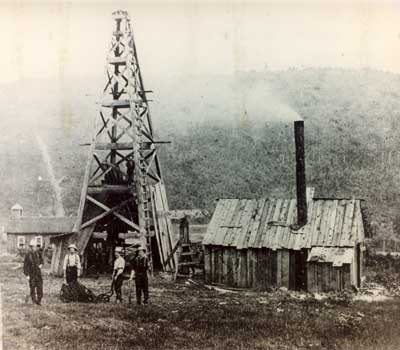 |
||||||
Wells and Operations
The farm commenced producing in 1861 and 62. There were twelve wells continuing in production in 1862 and two non-producing (depleted or awaiting pump?). The total daily production from all wells was 1300 barrels. These wells were in the flats and had drilled to the Venango Third sand, average depth slightly over 500 feet.
In 1865 the farm had 60 wells in production, 56 of them by pump. The total daily production was only 700 barrels. The price of oil in 1865 ranged from $4.62 to $8.25 per barrel. Ten wells were being drilled. Most of the wells were on the bottom lands, but a few were on the bluff. Obviously depletion and loss of pressure was taking place, but there was much territory to still drill, especially on the upper western hillside where activity was beginning to focus. It is noted with interest that there were 75 engines on the farm in 1865. After that year, the company drilled the upper hillsides with satisfactory results.
To show that a company can prosper without having a Hercules among its wells, Columbia Farm at the end of 1868 had only 23 pumping wells that averaged about 17 barrels per day per well. Their ledger book shows that this was sufficient production to earn a gross profit for the year (1868) of $381,000! At that time they were producing a barrel at a cost of $1.71 and obviously selling it for much more.
In addition to drilling and production, refining was also taking place on the farm. Three companies had made arrangements to refine Columbia Oil Company crude oil. The refineries were small and couldn’t handle all of the local production. The largest refinery, Crystal Oil Works, had a capacity of 440 barrels of crude per week.
Besides the company town, there were scattered boarding houses, hotels, offices, and shops. An attached map shows the farm as it supposedly was in 1865. However, that map may be incomplete as far as buildings are concerned. Some of the better known wells of the day are on it: Ram Cat, Maloney, Ladies’ Wells (5), Chimney, Titus, Big Tank, and others.
|
||
|
| © 2004, Samuel T. Pees all rights reserved |
|

